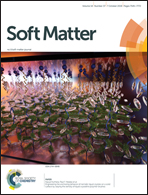Formation of core/corona nanoparticles with interpolyelectrolyte complex cores in aqueous solution: insight into chain dynamics in the complex from fluorescence quenching†
Abstract
Formation of interpolyelectrolyte complexes (IPECs) of poly(methacrylic acid) (PMAA) bearing a fluorescent label (umbelliferone) at the chain end and poly[3,5-bis(trimethyl ammoniummethyl)-4-hydroxystyrene iodide]-block-poly(ethylene oxide) (QNPHOS–PEO) acting as a fluorescence quencher, was followed using a combination of scattering, calorimetry, microscopy and fluorescence spectroscopy techniques. While scattering and microscopy measurements indicated formation of spherical core/corona nanoparticles with the core of the QNPHOS/PMAA complex and the PEO corona, fluorescence measurements showed that both static and dynamic quenching efficiency were increased in the nanoparticle stability region. As the dynamic quenching rate constant remained unchanged, the quenching enhancement was caused by the increase in the local concentration of QNPHOS segments in the microenvironment of the label. This finding implies that the local dynamics of PMAA end chains affecting the interaction of the label with QNPHOS segments was independent of both PMAA and QNPHOS chain conformations.



 Please wait while we load your content...
Please wait while we load your content...